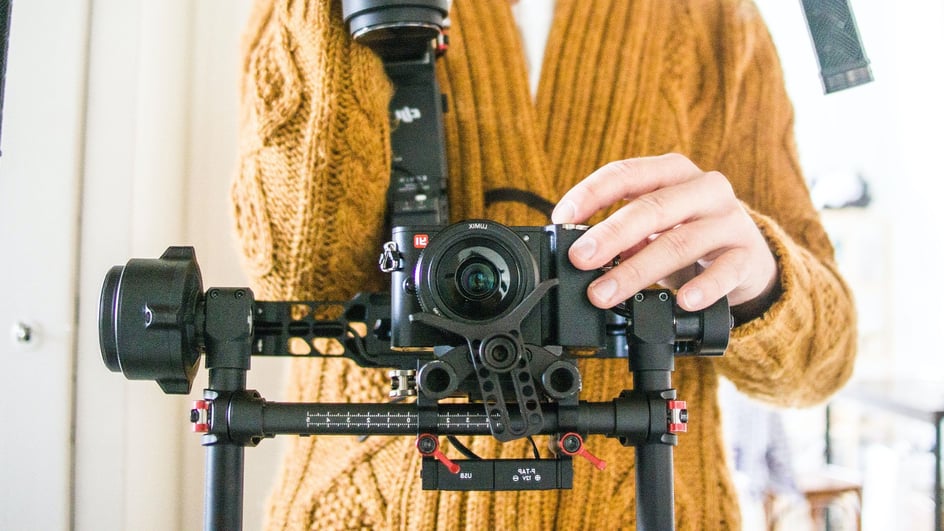
Mar 2, 2021
Not every filmmaker has access to the same types of equipment.
A solo creator producing a short film with minimal gear, for instance, works under different circumstances than a team involved in an indie film production.
With an abundance of products on the market, it can be challenging to sort out which ones are truly necessary from which ones aren’t.
And while many high-end microphones, cinema cameras, and gear yield great results for filmmakers, what simplifies one creator’s filming process might complicate yours.
To borrow from the YouTube creator Fellow Filmmaker, “Gear should never get in the way of what [you’re] really going after as a filmmaker, which is the story.”
Like many creators, Heather discovered early on in her career that a product can be top-of-the-line but still not compatible with your filming needs.
Because camera stabilizers run the gamut both price-wise and functionality-wise, it’s important that you have all of the information you need to find the most dependable option for you.
And what better resources are there for filmmakers than other filmmakers?
From general compatibility to product recommendations, this article functions as a sounding board for creators who work with camera stabilizers every day.
Choosing the Right Stabilizer for You
Capturing steady footage during a shoot is easier said than done, especially when filming on rough terrain and in difficult weather conditions.
A camera stabilizer is a piece of equipment that — if compatible with your camera and filming style — helps you capture the shot you want in the way you want.
The three main types of camera stabilizers are handheld, 3-axis gimbals, and vest stabilizers. Whether you’re in the market for your first camera stabilizer or a new one, there are several important factors to consider before making a purchase.
1. The Camera
Camera stabilizers are only effective when paired with the right sized cameras.
So it's always best to focus on finding the best camera for YouTube, film, etc. first and then go from there.
If a camera is too light for a stabilizer, the footage that you bring into post-production will be shaky and, possibly, unusable.
Most stabilizers that come at higher price points are built for heavier cameras, so if you’re working with lighter DSLR’s, you want to look for a quality product that has a lower weight capacity.
As a general rule, hold out on a stabilizer purchase until you know exactly which camera you will be using for your videos. Your camera’s weight is an important compatibility factor, but not the only one to consider.
For more versatility in long-term use, you might opt for a stabilizer with additional accessories and features (i.e. arm extensions, quick release mounting plates, etc.).
And if you're filming with a smartphone, you can find videography accessories for that too.
2. The Crew
Operating camera stabilizers for a long period of time can take a physical toll on your crew, especially in the case of vest stabilizers. While this type of stabilizer works wonders on set, it’s not necessarily the best fit for every crew member in every production.
If a stabilizer is renowned as top-quality, we are naturally more inclined to make a purchase. What often goes unsaid, however, is that this stabilizer might require more practice, strength, and expertise than you are able to manage.
For Fellow Filmmaker Heather Maione, she discovered the hard way that the Glidecam wasn’t compatible with her filming needs. Though this stabilizer provides great results for some filmmakers, this wasn’t the case for Heather.
If a product isn’t compatible with your experience level and physical capabilities, operating the stabilizer can be a constant struggle. While trial-and-error is inevitable, you can save a lot of time and money by asking other filmmakers about their experience with a product.
3. The Project
As you search for the right camera stabilizer, it’s important to maintain the long view and consider a product’s functionality for future projects.
Camera stabilizers play an important role in various types of video production outside of filmmaking. In which case, it’s important to prioritize versatility.
For wedding videographer Daniel Kuang and videographer Paul Richardson, a camera stabilizer that allows for light travel over longer periods of time is a non-negotiable. In their cases, a vest stabilizer doesn’t allow for the amount of mobility needed for the job and also draws (unwanted) attention to them.
According to Paul Richardson, a stabilizer like the Zhiyun Crane 3S is a practical alternative to vests or larger rigs because it allows him to travel light.
Richardson adds that the Zhiyun stabilizer helps him shave time off of production: “It speeds up my workflow massively as I can walk slowly and shoot, so a shot might take 5 minutes instead of 50.”
Choosing a camera stabilizer is an entirely subjective process. Depending on your filming style and needs, you may favor one type of stabilizer over the other. The important thing is to consider what product will benefit you in future projects as well as this current one.
Creator to Creator: Stabilizers Worth Your Investment
In this section, I relay a few of the go-to camera stabilizers and brands according to five creators. These creators specialize in various areas of video production and offer a lot of valuable insight for choosing the right stabilizer for your film.
1. DJI Ronin-S & Other Models
J.P. Scott, Director of Multimedia at Venta Marketing:
“We use the DJI Ronin-SC at almost every client shoot because it is super portable and easy to use...The DJI Ronin S2 and SC 2 are both fantastic budget stabilizers with some killer new features in the recently updated models…Bigger budget results at an indie budget price.”
Heather Maione, Fellow Filmmaker:
“About a year ago, I was working on a short video ad piece for a video contest I was entering. I chose to use my Ronin-S for the portion of the shoot where I was leaning out another car window to get those shots of the subject car traveling around on the road. I knew I needed the strong motors to handle the wind and bumps in the road. If I hadn't had the Ronin-S, those shots were going to be pretty rough to look at later.”
2. The Zhiyun Brand
Paul Richardson with Timepluslight:
“For timelapse you need the gimbal to stay perfectly locked when shooting - however nearly all gimbals on the market slowly drift to the left or right. [The Zhiyun Crane 3S] is one of the few gimbals I've tested that actually works, and keeps the gimbal pointing in the exact same direction.”
Brandon Ballweg, founder of ComposeClick:
“For videographers looking for a cheaper, more compact stabilizer capable of one-handed operation, I would check out something like the Zhiyun WEEBILL-S.”
3. Easyrig
Chris Haggerty, one of Soundstripe’s resident filmmakers:
“[Vest stabilizers] such as the Easyrig, are incredibly helpful for filmmakers who want a handheld look without breaking their back...These rigs are most helpful at redistributing the weight of the camera from your arms and back, to your waist and legs. This allows you to keep the camera handheld for much longer periods of time.”
4. Maza Lite 2
Brandon Ballweg, founder of ComposeClick:
“[The Moza Lite 2] does an excellent job of stabilizing your camera while shooting video, which results in really smooth footage. It's also very comfortable to hold and durable.”
Finding a Stabilizer for Your Budget
Though the bare bones of production are more-or-less the same for every creator (i.e., pre-production, production, and post-production), the process looks different for everyone.
The gear that you have on hand affects, but does not make or break, this process. Before you invest in your first or next camera stabilizer, take some time to evaluate whether a product is physically and logistically compatible with your filming style and needs.
Heather Maione articulates it best: “Likely what you use as gear today will change in five years, so be willing to learn the basics and adapt. Ability to adapt and tell a good visual story is what truly makes a great filmmaker.”
